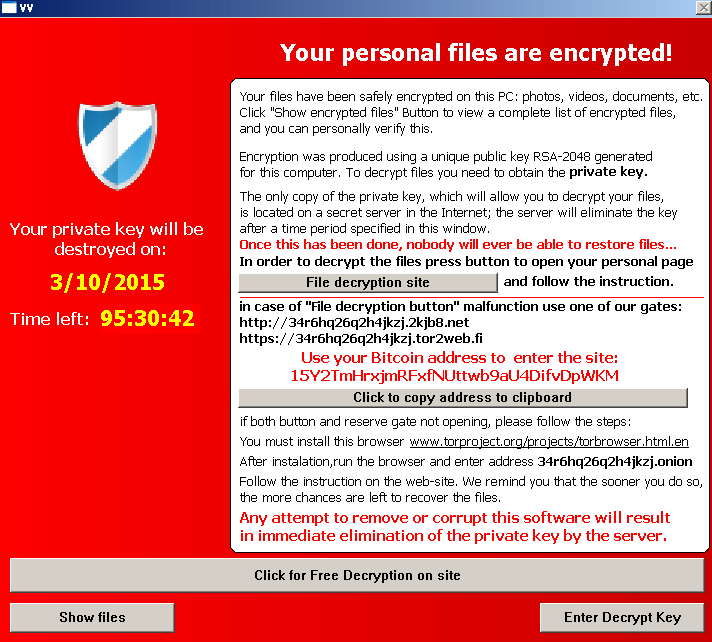
Αυξημένες καταγγελίες για είδος ιού δέχεται το τελευταίο διάστημα το Γραφείο Καταπολέμησης Ηλεκτρονικού Εγκλήματος.
Οι νέες καταγγελίες, αφορούν ιό τύπου TELSA CRYPT (ο αλγόριθμος
κρυπτογράφησης είναι RSA-4096 bytes), με τον οποίο μολύνονται
Ηλεκτρονικοί Υπολογιστές και εξυπηρετητές (Server) εταιρειών, γραφείων ή
άλλων χρηστών.
κρυπτογράφησης είναι RSA-4096 bytes), με τον οποίο μολύνονται
Ηλεκτρονικοί Υπολογιστές και εξυπηρετητές (Server) εταιρειών, γραφείων ή
άλλων χρηστών.
Ο συγκεκριμένος Ιός αποστέλλεται μέσω ηλεκτρονικού μηνύματος με
παραπλανητικό τίτλο, ή/και περιεχόμενο. Ο αποστολέας του μηνύματος,
είναι πιθανόν να προέρχεται από τις επαφές του χρήστη.
παραπλανητικό τίτλο, ή/και περιεχόμενο. Ο αποστολέας του μηνύματος,
είναι πιθανόν να προέρχεται από τις επαφές του χρήστη.
Στο μήνυμα, υπάρχει και ένα επισυναπτόμενο αρχείο (attachment) σε
συμπιεσμένη μορφή (.zip), το οποίο όταν ανοιχθεί, κλειδώνουν όλα τα
αρχεία του υπολογιστή (encrypted). Ο υπολογιστής αμέσως εμφανίζει ένα
μήνυμα όπου καταγράφεται ο τρόπος, που μπορεί κάποιος να επαναφέρει τα
αρχεία του.
συμπιεσμένη μορφή (.zip), το οποίο όταν ανοιχθεί, κλειδώνουν όλα τα
αρχεία του υπολογιστή (encrypted). Ο υπολογιστής αμέσως εμφανίζει ένα
μήνυμα όπου καταγράφεται ο τρόπος, που μπορεί κάποιος να επαναφέρει τα
αρχεία του.
Να σημειωθεί ότι στο παρόν στάδιο δεν υπάρχει επιβεβαιωμένος τρόπος ή
λογισμικό για την επαναφορά των αρχείων που έχουν κρυπτογραφηθεί από τον
ιό.
λογισμικό για την επαναφορά των αρχείων που έχουν κρυπτογραφηθεί από τον
ιό.
Ο συγκεκριμένος ιός είναι γνωστός στις Αστυνομικές Αρχές και ήδη το
Γραφείο Καταπολέμησης Ηλεκτρονικού Εγκλήματος, έχει στείλει ηλεκτρονικά
δεδομένα στην Europol, για περαιτέρω επεξεργασία και ανάλυση του Ιού.
Γραφείο Καταπολέμησης Ηλεκτρονικού Εγκλήματος, έχει στείλει ηλεκτρονικά
δεδομένα στην Europol, για περαιτέρω επεξεργασία και ανάλυση του Ιού.
Καλείται το κοινό να είναι προσεκτικό με τον χειρισμό του ηλεκτρονικού
του ταχυδρομείου και να μην ανοίγουν άγνωστα ηλεκτρονικά μηνύματα
(e-mail). Δίδεται η συμβουλή όπως όλοι οι χρήστες, εταιρείες πρέπει να
έχουν οπωσδήποτε αντίγραφα ασφαλείας (backup) για την επαναφορά των
αρχείων σε ξεχωριστή μονάδα αποθήκευσης. Επίσης να έχουν όλες τις
ενημερώσεις ασφαλείας των λειτουργικών συστημάτων (updates) καθώς επίσης
και τις τελευταίες ενημερώσεις των λογισμικών κατά των ιών (antivirus
updates).
- See more at: http://www.sigmalive.com/news/scitech/technology/310970/neos-ios-mastizei-to-diadiktyo#sthash.2OREezxR.dpufτου ταχυδρομείου και να μην ανοίγουν άγνωστα ηλεκτρονικά μηνύματα
(e-mail). Δίδεται η συμβουλή όπως όλοι οι χρήστες, εταιρείες πρέπει να
έχουν οπωσδήποτε αντίγραφα ασφαλείας (backup) για την επαναφορά των
αρχείων σε ξεχωριστή μονάδα αποθήκευσης. Επίσης να έχουν όλες τις
ενημερώσεις ασφαλείας των λειτουργικών συστημάτων (updates) καθώς επίσης
και τις τελευταίες ενημερώσεις των λογισμικών κατά των ιών (antivirus
updates).
Αυξημένες καταγγελίες για είδος ιού δέχεται το τελευταίο διάστημα το Γραφείο Καταπολέμησης Ηλεκτρονικού Εγκλήματος.
Οι νέες καταγγελίες, αφορούν ιό τύπου TELSA CRYPT (ο αλγόριθμος κρυπτογράφησης είναι RSA-4096 bytes), με τον οποίο μολύνονται Ηλεκτρονικοί Υπολογιστές και εξυπηρετητές (Server) εταιρειών, γραφείων ή άλλων χρηστών.
Ο συγκεκριμένος Ιός αποστέλλεται μέσω ηλεκτρονικού μηνύματος με παραπλανητικό τίτλο, ή/και περιεχόμενο. Ο αποστολέας του μηνύματος, είναι πιθανόν να προέρχεται από τις επαφές του χρήστη.
Στο μήνυμα, υπάρχει και ένα επισυναπτόμενο αρχείο (attachment) σε συμπιεσμένη μορφή (.zip), το οποίο όταν ανοιχθεί, κλειδώνουν όλα τα αρχεία του υπολογιστή (encrypted). Ο υπολογιστής αμέσως εμφανίζει ένα μήνυμα όπου καταγράφεται ο τρόπος, που μπορεί κάποιος να επαναφέρει τα αρχεία του.
Να σημειωθεί ότι στο παρόν στάδιο δεν υπάρχει επιβεβαιωμένος τρόπος ή λογισμικό για την επαναφορά των αρχείων που έχουν κρυπτογραφηθεί από τον ιό.
Ο συγκεκριμένος ιός είναι γνωστός στις Αστυνομικές Αρχές και ήδη το Γραφείο Καταπολέμησης Ηλεκτρονικού Εγκλήματος, έχει στείλει ηλεκτρονικά δεδομένα στην Europol, για περαιτέρω επεξεργασία και ανάλυση του Ιού.
Καλείται το κοινό να είναι προσεκτικό με τον χειρισμό του ηλεκτρονικού του ταχυδρομείου και να μην ανοίγουν άγνωστα ηλεκτρονικά μηνύματα (e-mail). Δίδεται η συμβουλή όπως όλοι οι χρήστες, εταιρείες πρέπει να έχουν οπωσδήποτε αντίγραφα ασφαλείας (backup) για την επαναφορά των αρχείων σε ξεχωριστή μονάδα αποθήκευσης. Επίσης να έχουν όλες τις ενημερώσεις ασφαλείας των λειτουργικών συστημάτων (updates) καθώς επίσης και τις τελευταίες ενημερώσεις των λογισμικών κατά των ιών (antivirus updates).
Αυξημένες καταγγελίες για είδος ιού δέχεται το τελευταίο διάστημα το Γραφείο Καταπολέμησης Ηλεκτρονικού Εγκλήματος.
Οι νέες καταγγελίες, αφορούν ιό τύπου TELSA CRYPT (ο αλγόριθμος
κρυπτογράφησης είναι RSA-4096 bytes), με τον οποίο μολύνονται
Ηλεκτρονικοί Υπολογιστές και εξυπηρετητές (Server) εταιρειών, γραφείων ή
άλλων χρηστών.
κρυπτογράφησης είναι RSA-4096 bytes), με τον οποίο μολύνονται
Ηλεκτρονικοί Υπολογιστές και εξυπηρετητές (Server) εταιρειών, γραφείων ή
άλλων χρηστών.
Ο συγκεκριμένος Ιός αποστέλλεται μέσω ηλεκτρονικού μηνύματος με
παραπλανητικό τίτλο, ή/και περιεχόμενο. Ο αποστολέας του μηνύματος,
είναι πιθανόν να προέρχεται από τις επαφές του χρήστη.
παραπλανητικό τίτλο, ή/και περιεχόμενο. Ο αποστολέας του μηνύματος,
είναι πιθανόν να προέρχεται από τις επαφές του χρήστη.
Στο μήνυμα, υπάρχει και ένα επισυναπτόμενο αρχείο (attachment) σε
συμπιεσμένη μορφή (.zip), το οποίο όταν ανοιχθεί, κλειδώνουν όλα τα
αρχεία του υπολογιστή (encrypted). Ο υπολογιστής αμέσως εμφανίζει ένα
μήνυμα όπου καταγράφεται ο τρόπος, που μπορεί κάποιος να επαναφέρει τα
αρχεία του.
συμπιεσμένη μορφή (.zip), το οποίο όταν ανοιχθεί, κλειδώνουν όλα τα
αρχεία του υπολογιστή (encrypted). Ο υπολογιστής αμέσως εμφανίζει ένα
μήνυμα όπου καταγράφεται ο τρόπος, που μπορεί κάποιος να επαναφέρει τα
αρχεία του.
Να σημειωθεί ότι στο παρόν στάδιο δεν υπάρχει επιβεβαιωμένος τρόπος ή
λογισμικό για την επαναφορά των αρχείων που έχουν κρυπτογραφηθεί από τον
ιό.
λογισμικό για την επαναφορά των αρχείων που έχουν κρυπτογραφηθεί από τον
ιό.
Ο συγκεκριμένος ιός είναι γνωστός στις Αστυνομικές Αρχές και ήδη το
Γραφείο Καταπολέμησης Ηλεκτρονικού Εγκλήματος, έχει στείλει ηλεκτρονικά
δεδομένα στην Europol, για περαιτέρω επεξεργασία και ανάλυση του Ιού.
Γραφείο Καταπολέμησης Ηλεκτρονικού Εγκλήματος, έχει στείλει ηλεκτρονικά
δεδομένα στην Europol, για περαιτέρω επεξεργασία και ανάλυση του Ιού.
Καλείται το κοινό να είναι προσεκτικό με τον χειρισμό του ηλεκτρονικού
του ταχυδρομείου και να μην ανοίγουν άγνωστα ηλεκτρονικά μηνύματα
(e-mail). Δίδεται η συμβουλή όπως όλοι οι χρήστες, εταιρείες πρέπει να
έχουν οπωσδήποτε αντίγραφα ασφαλείας (backup) για την επαναφορά των
αρχείων σε ξεχωριστή μονάδα αποθήκευσης. Επίσης να έχουν όλες τις
ενημερώσεις ασφαλείας των λειτουργικών συστημάτων (updates) καθώς επίσης
και τις τελευταίες ενημερώσεις των λογισμικών κατά των ιών (antivirus
updates).
- See more at: http://www.sigmalive.com/news/scitech/technology/310970/neos-ios-mastizei-to-diadiktyo#sthash.2OREezxR.dpufτου ταχυδρομείου και να μην ανοίγουν άγνωστα ηλεκτρονικά μηνύματα
(e-mail). Δίδεται η συμβουλή όπως όλοι οι χρήστες, εταιρείες πρέπει να
έχουν οπωσδήποτε αντίγραφα ασφαλείας (backup) για την επαναφορά των
αρχείων σε ξεχωριστή μονάδα αποθήκευσης. Επίσης να έχουν όλες τις
ενημερώσεις ασφαλείας των λειτουργικών συστημάτων (updates) καθώς επίσης
και τις τελευταίες ενημερώσεις των λογισμικών κατά των ιών (antivirus
updates).


